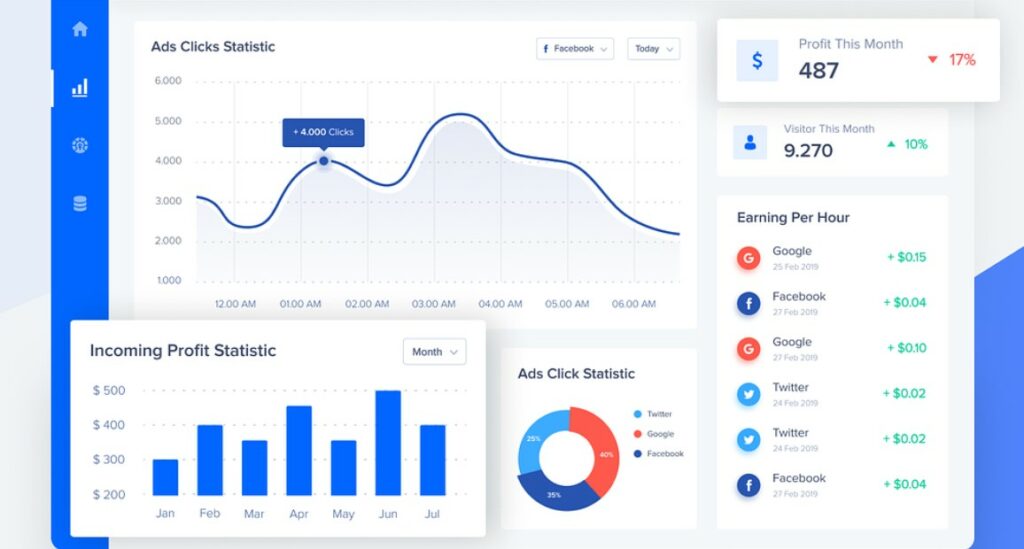Welcome to the digital age, where the customer experience reigns supreme. In this era, businesses must go beyond mere online existence and strive to create extraordinary experiences that captivate customers across multiple channels. This is where the omnichannel approach comes into play. The digital customer experience encompasses every interaction and engagement between a company and its customers in the vast online realm. From browsing websites and using mobile apps to engaging on social media platforms and receiving personalized emails, every touchpoint contributes to shaping this immersive journey.
Click here to discover how to create a digital customer marketing strategy!
So, why is mastering the art of delivering exceptional digital experiences paramount?
- The Definition of Digital Customer Experience:
- It covers every touchpoint throughout a customer’s online journey.
- It extends beyond just making a purchase; it includes interactions before, during, and after.
- Personalization takes center stage as tailored content and solutions catered to individual needs become key.
- The Importance of Elevating Your Game:
- Customers now demand convenience and efficiency in their online encounters.
- A positive digital customer experience fosters trust and cultivates unwavering loyalty.
- By prioritizing your customers’ needs above all else, you gain an undeniable competitive edge.
- Unlocking Satisfaction & Fueling Growth:
- Satisfied customers are more likely to become repeat buyers who keep coming back for more.
- Positive word-of-mouth recommendations from these satisfied customers open doors for new business opportunities.
- When businesses focus on enhancing their overall digital customer experience, revenue growth becomes an achievable reality.
By embracing an omnichannel approach that seamlessly integrates various channels into one cohesive strategy, companies can unlock unparalleled success in today’s ever-evolving landscape. Join us as we embark on this transformative journey together, exploring the latest trends and strategies to create unforgettable digital experiences that leave a lasting impact.
The Omnichannel Approach: A Game Changer
Welcome to the world of digital customer experience enhancement! In this section, we will dive into the powerful concept of the omnichannel approach and how it can revolutionize your interactions with customers.
Definition and Explanation of the Omnichannel Approach
The omnichannel approach refers to creating a seamless and integrated customer experience across multiple channels, both online and offline. With an omnichannel strategy, you can provide consistent branding, messaging, and service throughout every step of your customer’s journey.
By adopting an omnichannel approach, you not only improve customer experiences but also boost your business performance. Studies show that companies with strong omnichannel strategies achieve higher customer retention rates and increased revenue growth compared to those who rely solely on single-channel approaches. So, how can you create such a seamless experience for your customers? Keep reading to learn all about it!
Benefits of Implementing an Omnichannel Approach
Implementing an omnichannel approach is a game changer for businesses like yours. It offers several benefits:
- Enhanced Customer Satisfaction: By creating a seamless and personalized experience across multiple channels, you demonstrate to your customers that they are truly valued and understood. This approach allows them to have a consistent and enjoyable journey with your brand, resulting in increased satisfaction.
- Increased Customer Loyalty: When every interaction point with your digital presence leaves a positive impression, customers not only become loyal advocates but also willingly recommend your products or services to others. Their loyalty is built on the foundation of exceptional experiences that consistently exceed their expectations.
- Improved Business Performance: Implementing an effective omnichannel strategy can significantly boost sales revenue and enhance operational efficiency. By streamlining processes and eliminating redundancies, you create a more efficient business model that maximizes productivity while delivering outstanding customer service.
- Competitive Advantage: In today’s fast-paced market, companies that embrace the power of an omnichannel approach gain a significant competitive edge over their counterparts who solely rely on traditional marketing methods. The ability to connect with customers across various channels enables businesses to stay ahead of evolving trends and meet customer demands effectively.
By adopting an omnichannel strategy, businesses can build strong relationships with their customers by providing tailored solutions for all their needs. This comprehensive guide will show you how to leverage the latest trends in omnichannel marketing to improve customer experiences at every touchpoint. Discover what it takes to create a seamless journey for your customers across all digital channels and learn from real-life examples of companies that have successfully implemented these strategies. Don’t miss out on this opportunity! Take advantage of the power of omnichannel now and revolutionize the way you engage with your audience.

Real-Life Examples of Successful Omnichannel Strategies
Let’s take a look at some real-life success stories from industry leaders:
- Starbucks: This global coffee chain has mastered delivering exceptional experiences through its seamless omnichannel presence.
- Nike: With its NikePlus membership program, Nike offers personalized recommendations based on users’ preferences gathered from various touchpoints.
- Sephora: This beauty retailer has perfected the art of a seamless shopping experience.
These examples demonstrate how companies can leverage the power of an omnichannel approach to forge deep connections with their customers while driving business growth. In the next section, we will delve into practical steps for implementing an omnichannel approach to enhance your digital customer experience. Stay tuned!
How To Enhance the Digital Customer Experience with an Omnichannel Approach
Welcome to our expert guide on enhancing the digital customer experience through the power of omnichannel strategies. In this section, we will walk you through a step-by-step process that will help you successfully implement an omnichannel approach and elevate your customers’ overall satisfaction.
1. Understand Your Customers
The first crucial step in enhancing the digital customer experience is gaining a deep understanding of your target audience. Conduct thorough market research and gather data about their preferences, behaviors, and needs to tailor your omnichannel strategy effectively.
2. Map Out the Customer Journey
Once armed with valuable insights about your customers, it’s time to map out their journey across multiple channels. Identify touchpoints where they interact with your brand and carefully analyze each interaction for potential improvements or gaps in the customer experience.
3. Integrate Channels Seamlessly
An effective omnichannel strategy requires seamless integration across all channels – from social media platforms to websites and mobile apps. Ensure that customers can transition effortlessly between these channels without any disruptions or inconsistencies in messaging.
4. Personalize Interactions
Personalization is key when it comes to creating exceptional digital experiences for customers. Utilize advanced data analytics tools to segment your audience and deliver personalized content and recommendations tailored specifically for each individual.
5. Provide Consistent Messaging
Consistency plays a vital role in delivering an outstanding digital customer experience through an omnichannel approach. Maintain consistent branding elements such as logos, colors, tone of voice, and messaging across all channels to create a cohesive brand identity that resonates deeply with customers.
6. Offer Multiple Communication Channels
Empower your customers by offering them various communication options such as live chat support, email assistance, phone calls, or social media interactions. This allows them to choose their preferred method of contact while ensuring prompt responses and efficient problem resolution.
7. Implement Automation Tools
Embrace the power of automation tools to enhance the efficiency and effectiveness of your omnichannel strategy. Leverage chatbots, automated email campaigns, and customer relationship management (CRM) systems to streamline processes, provide quick responses, and deliver personalized experiences at scale.
8. Continuously Monitor and Optimize
Enhancing the digital customer experience is an ongoing journey. Regularly monitor key performance indicators (KPIs) such as customer satisfaction scores, conversion rates, or average response times to identify areas for improvement. Utilize this valuable data to continuously optimize your omnichannel strategy.
9. Train Your Team
A well-trained team is essential for successfully implementing an omnichannel approach. Provide comprehensive training on effectively using various channels, handling customer interactions with empathy and professionalism, and leveraging automation tools to enhance productivity.
10. Seek Customer Feedback
Actively seek feedback from your customers through surveys or feedback forms to gain insights into their satisfaction levels with your digital customer experience efforts. Use this invaluable feedback to make necessary adjustments and real-time improvements.
By following these expert steps and best practices for enhancing the digital customer experience with an omnichannel approach, you can create a seamless journey for your customers across multiple channels while building strong relationships that drive business growth.

Measuring the Success of Your Omnichannel Strategy
To truly harness the potential of your omnichannel strategy, it is essential to measure its success and continuously strive for improvement. By closely monitoring key performance indicators (KPIs) and leveraging cutting-edge tools and technologies, you can gain invaluable insights into customer behavior and optimize your approach.
1. Tracking Key Performance Indicators
- Conversion Rate: Gauge the percentage of customers who take desired actions, such as making a purchase or subscribing to a newsletter.
- Customer Satisfaction Score (CSAT): Assess customer satisfaction levels through surveys or feedback mechanisms.
- Net Promoter Score (NPS): Determine how likely customers are to recommend your brand to others.
- Average Order Value (AOV): Calculate the average amount spent by customers per transaction.
- Return on Investment (ROI): Evaluate the financial impact of your omnichannel efforts.
2. Empowering Measurement with Tools and Technologies
- Customer Relationship Management (CRM) Systems: Capture comprehensive customer data across multiple channels for personalized interactions and insightful analysis.
- Web Analytics Platforms: Monitor website traffic, user behavior, conversion rates, and other relevant metrics to uncover valuable trends.
- Social Media Listening Tools: Gather real-time insights from social media platforms about customer sentiment towards your brand.
- Surveys and Feedback Mechanisms: Collect direct feedback from customers regarding their experiences across different channels.
3. Analyzing Results for Actionable Insights
Once you have gathered data using these powerful tools, it’s crucial to analyze it effectively in order to extract actionable insights. Consider these steps when interpreting results:
- Identify emerging trends or patterns that span various channels or touchpoints.
- Compare KPIs against industry benchmarks or previous periods for meaningful context.
- Segment data based on demographics or specific customer groups to uncover hidden opportunities.
- Seek correlations between different metrics to unveil valuable relationships.
- Utilize data visualization techniques to present findings in a visually compelling and easily understandable manner.
Measuring the success of your omnichannel strategy empowers you to identify areas for improvement, optimize customer experiences, and drive remarkable business growth. By consistently monitoring KPIs and harnessing the power of advanced tools, you can make informed decisions that elevate your digital customer experience to new heights.
The Future of Digital Customer Experience and Omnichannel
As we gaze into the future, it becomes abundantly clear that the digital customer experience and omnichannel approach will be paramount to achieving business success. Let’s explore some predictions and trends for the future of digital customer experience:
- Personalization: Customers demand personalized experiences across all channels. Businesses must harness the power of data analytics and artificial intelligence to deliver highly tailored experiences that cater to individual needs and preferences.
- Voice Technology: With the surge in popularity of smart speakers and virtual assistants, voice technology is gaining significant traction. Businesses should consider integrating voice capabilities into their omnichannel strategies.
- Augmented Reality (AR) and Virtual Reality (VR): AR and VR technologies have already begun revolutionizing various industries. In the near future, these immersive technologies will empower businesses to create unparalleled digital experiences that captivate customer engagement.
- Internet of Things (IoT): The IoT enables devices to connect with one another via the Internet, opening up opportunities for businesses to gather real-time data on customer behavior.
To stay ahead in this ever-evolving digital landscape, here are some expert tips:
- Embrace Innovation: Continuously explore new technologies and solutions that can enhance your omnichannel strategy.
- Foster Collaboration: Encourage cross-functional collaboration between departments such as marketing, sales, IT, and customer service teams.
- Invest in Training & Development: Equip your employees with the skills necessary for implementing an effective omnichannel strategy.
- Prioritize Continuous Improvement: Regularly analyze customer feedback and data to identify areas for improvement in your omnichannel strategy.
In conclusion, the future of digital customer experience lies in creating seamless and personalized interactions across multiple channels. By embracing emerging technologies, fostering collaboration within your organization, investing in training programs, and prioritizing continuous improvement, you can provide customers with extraordinary experiences that drive business growth.
Conclusion: Unleashing the Power of Omnichannel Experience
In today’s digital age, businesses must understand the importance of delivering exceptional experiences to their customers across multiple channels. This is where omnichannel strategies come into play.
An omnichannel experience is a seamless approach that allows customers to interact with your brand through various channels, be it online or offline. It goes beyond simply having a presence on different platforms; it involves creating a cohesive journey for your customers, regardless of which channel they choose to engage with. By implementing an effective omnichannel strategy, you can build stronger relationships with your customers and enhance their overall satisfaction.
Imagine a customer browsing through your blog and seamlessly transitioning to making a purchase on your website without any hiccups. That’s the power of an optimized omnichannel experience. But why should companies invest in creating such experiences?
The answer lies in the ever-evolving expectations of modern consumers. Today’s customers expect personalized interactions tailored to their preferences and needs. They want convenience, consistency, and relevance throughout their buying journey. Omnichannel marketing enables you to meet these expectations by providing consistent messaging and branding across all touchpoints – whether it’s social media platforms, email campaigns, or physical stores. By doing so, you not only create memorable experiences but also foster loyalty among your customer base.
Moreover, embracing an omnichannel approach opens up new opportunities for growth and expansion.
As technology continues to advance rapidly, staying ahead of trends becomes crucial for businesses looking to thrive in this competitive landscape. An omni CX strategy allows you to adapt quickly while keeping pace with evolving consumer behaviors.
To successfully implement an effective omnichannel strategy:
- Understand Your Customers: Gain deep insights into who your target audience is – their preferences, pain points, and behavior patterns across different channels.
- Map Their Journey: Identify the touchpoints where customers interact with your brand and ensure a seamless transition between them.
- Leverage Technology: Invest in robust digital solutions that enable you to track customer interactions, personalize experiences, and automate processes.
- Align Your Teams: Break down silos within your organization and foster collaboration among different departments to deliver consistent messaging and experiences.
- Continuously Optimize: Regularly analyze data, gather feedback, and make necessary adjustments to improve your omnichannel strategy.
In conclusion, an effective omnichannel experience is not just a buzzword; it’s a game-changer for businesses looking to thrive in today’s digital landscape.
By creating seamless journeys across multiple channels, you can build stronger relationships with your customers while staying ahead of industry trends. So don’t wait – unlock the power of the omnichannel experience and elevate your business to new heights.






